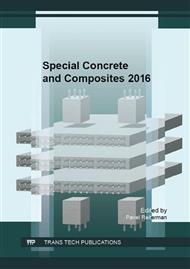[1]
C. Montoja et al., Study of ancient dolomitic mortars of the church of Santa Marı́a de Zamarce in Navarra (Spain): comparison with simulated standards, Thermochim. Acta 398 (2003) 107-122.
DOI: 10.1016/s0040-6031(02)00321-0
Google Scholar
[2]
I. Villaseñor, C.A. Price, Technology and decay of magnesian lime plasters: the sculptures of the funerary crypt of Palenque, Mexico, J. Archaeol. Sci. 35 (2008) 1030-1039.
DOI: 10.1016/j.jas.2007.07.006
Google Scholar
[3]
S. Bruni, F. Cariati, P. Fermo, A. Pozzi, L. Toniolo, Characterization of ancient mortars coming from northern Italy, Termochim. Acta 321 (1998) 161-165.
DOI: 10.1016/s0040-6031(98)00455-9
Google Scholar
[4]
S. Vecchio, A. Laginestra, A. Frezza, C. Ferragina, The use of thermoanalytical techniques in the characterization of ancient mortars, Termochim. Acta 227 (1993) 215-223.
DOI: 10.1016/0040-6031(93)80264-b
Google Scholar
[5]
A. Arizzi, R. Hendrickx, G. Cultrone, K. Van Balen, Differences in the rheological properties of calcitic and dolomitic lime slurries: influence of particle characteristics and practical implications in lime-based mortar manufacturing, Mater. Constr. 60 (2012).
Google Scholar
[6]
L. Chever, S. Pavía, R. Howard, Physical properties of magnesian lime mortars, Mater. Struct. 43 (2010) 283–296.
DOI: 10.1617/s11527-009-9488-9
Google Scholar
[7]
G. Cultrone, A. Arizzi, E. Sebastián, C. Rodriguez-Navarro, Sulfation of calcitic and dolomitic lime mortars in the presence of diesel particulate matter, Environ. Geol. 56 (2008) 741-752.
DOI: 10.1007/s00254-008-1379-9
Google Scholar
[8]
J. Lanas, J.L.P. Bernal, M.A. Bello, J.I. Alvarez, Mechanical properties of masonry repair dolomitic lime-based mortars. Cem. Concr. Res. 36 (2006) 951–960.
DOI: 10.1016/j.cemconres.2005.10.004
Google Scholar
[9]
J.S. Pozo-Antonio, Evolution of mechanical properties and drying shrinkage in lime-based and lime cement-based mortars with pure limestone aggregate, Constr. Build. Mater. 77 (2015) 472–478.
DOI: 10.1016/j.conbuildmat.2014.12.115
Google Scholar
[10]
S. Holmes, M. Wingate, Building with Lime: a Practical Introduction. ITDG, London, (1995).
Google Scholar
[11]
S. Pavía, B. Toomey, Influence of the aggregate quality on the physical properties of natural feebly-hydraulic lime mortars, Mater. Struct. 41 (2008) 559–569.
DOI: 10.1617/s11527-007-9267-4
Google Scholar
[12]
J. Lanas, J.I. Perez Bernal, M.A. Bello, J.I. Alvarez, Mechanical properties of naturally hydraulic lime based mortars, Cem. Concr. Res. 34 (2004) 2191–2201.
DOI: 10.1016/j.cemconres.2004.02.005
Google Scholar
[13]
M. Stefanidou, I. Papayiannai, The role of aggregate on the structure and properties of lime mortars, Cem. Concr. Compos. 27 (2005) 914–919.
Google Scholar
[14]
ČSN EN 459-1: Building lime – Part 3: Conformity evaluation (2015).
Google Scholar
[15]
ČSN EN 1015-3: Methods of test for mortar for masonry - Part 3: Determination of consistence of fresh mortar (by flow table) (2000).
DOI: 10.3403/01541440
Google Scholar
[16]
ČSN EN 1015-11: Methods of test for mortar for masonry - Part 11: Determination of flexural and compressive strength of hardened mortar (2000).
DOI: 10.3403/01905442
Google Scholar
[17]
ČSN EN 13755: Natural stone test methods - Determination of water absorption at atmospheric pressure (2008).
Google Scholar
[18]
ČSN EN 1015-18: Methods of test for mortar for masonry - Part 18: Determination of water absorption coefficient due to capillarity action of hardened mortar (2003).
DOI: 10.3403/02720093u
Google Scholar
[19]
R. Černý, J. Poděbradská, J. Drchalová, Water and Water Vapor Penetration through Coatings, J. Therm. Envelope. Build. Sci. 26 (2002) 165-177.
DOI: 10.1177/0075424202026002975
Google Scholar
[20]
M. Vyšvařil, T. Žižlavský, P. Bayer, The effect of aggregate type on the properties of lime mortars, submitted to Applied Mechanics and Materials (2016).
DOI: 10.4028/www.scientific.net/amm.861.141
Google Scholar
[21]
ČSN EN 998-2, Specification for Mortar for Masonry. Part. 2: Masonry Mortar (2003).
Google Scholar


